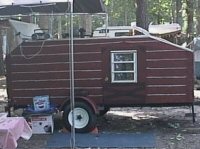Piccolo light? Comments from Andrew or anyone else?
17 posts
• Page 1 of 2 • 1, 2
Piccolo light? Comments from Andrew or anyone else?
Andrew,
I’ve taken a look at your frame design for the piccolo and must say it’s a nice piece of work. I’ve been thinking of how I might get a bit more weight out and wondered what you thought of making a material switch to Aluminum (assuming the increased cost of materials is not a problem).
Structurally speaking
The 14 gage steel has a wall thickness of .062 inch whereas the Aluminum tubing has .125 walls. So, the moment of inertia for the Aluminum is .3317 in4 -- up from .186 in4 for the steel. Therefore the stress for the Aluminum goes down. As I showed last year sometime the allowables aren’t too much different between half-decent Al (the 6061 is readily available and also weldable) and steel so I think it’s not a strength issue per se. The Young’s modulus drops from 29 to 10.1; so, overall the stiffness would drop some. Although you don’t want to be towing a wet noodle or anything, I’m thinking using the Aluminum would be stiff enough. I don’t weld Aluminum myself, but it’s easy enough to hire and I could cut and prep all of the parts so only the welding would be left.
Galvanic corrosion
I was also thinking that I could use a layer of dielectric tape between the half axles and the frame and also between the coupler and frame, use composite (fiberglass) washers and wet-install the fasteners to decouple the aluminum from the steel. (DO you think I might ned to go with Titanium fasteners? They aren’t that expensive since I won’t be using so many of them.
Not shown in drawing
The attachment of the 1.5â€
I’ve taken a look at your frame design for the piccolo and must say it’s a nice piece of work. I’ve been thinking of how I might get a bit more weight out and wondered what you thought of making a material switch to Aluminum (assuming the increased cost of materials is not a problem).
Structurally speaking
The 14 gage steel has a wall thickness of .062 inch whereas the Aluminum tubing has .125 walls. So, the moment of inertia for the Aluminum is .3317 in4 -- up from .186 in4 for the steel. Therefore the stress for the Aluminum goes down. As I showed last year sometime the allowables aren’t too much different between half-decent Al (the 6061 is readily available and also weldable) and steel so I think it’s not a strength issue per se. The Young’s modulus drops from 29 to 10.1; so, overall the stiffness would drop some. Although you don’t want to be towing a wet noodle or anything, I’m thinking using the Aluminum would be stiff enough. I don’t weld Aluminum myself, but it’s easy enough to hire and I could cut and prep all of the parts so only the welding would be left.
Galvanic corrosion
I was also thinking that I could use a layer of dielectric tape between the half axles and the frame and also between the coupler and frame, use composite (fiberglass) washers and wet-install the fasteners to decouple the aluminum from the steel. (DO you think I might ned to go with Titanium fasteners? They aren’t that expensive since I won’t be using so many of them.
Not shown in drawing
The attachment of the 1.5â€
-

kennyrayandersen - 1000 Club

- Posts: 1750
- Images: 38
- Joined: Sun Apr 29, 2007 10:27 pm
- Location: TX
Aluminium can undoubtedly work - there's no shortage of aluminium trailers being towed around. The problem I have is in estimating how strong the aluminium needs to be. Aluminium trailer manufacturers can use their experience but I don't have that.
It's probably not maximum strength (or stiffness) with the aluminium that is the critical design issue, but the fatigue strength. With steel that is rarely a problem but with aluminium, and often particularly with high strength aluminium, it is. This is the reason after all why airplanes have a design life.
On galvanic corrosion, I wouldn't be worried. Are you really going to be keeping the trailer in a conductive environment? If you want to spend each weekend towing the trailer down a salt water beach, then it could be an issue - mark you, then all corrosion would become an issue.
The simplest way to deal with galvanic corrosion, if it remains a concern, is to assemble all the dissimilar metals using a coat of chromate jointing compound. Here in Britain we would use Duralac but I think this is just a copy of a US MilSpec product - aircraft supply shops should be able to supply it. Of course it's expensive, but one toothpaste-sized tube would be more than enough for a trailer. It protects steel and aluminium boat parts in a salt water environment, so it's fine for a trailer, and possibly overkill.
Sorry, I really can't understand the channel description - I think a sketch is needed.
Aligning half-axles is really not difficult - it's really no harder than putting a full axle on straight. The trick is not to try to align the mounting bolt holes but to bolt the half-axles to the mouting plates, align that assembly to the trailer frame and then tack wled the mounting plates to the frame. Putting a straight-edge across each hub and making sure they are parallel is all that is needed. Talk of toe-in and toe-out is for cars with delicate steering setup - this is a trailer and it just isn't that sensitive.
Andrew
It's probably not maximum strength (or stiffness) with the aluminium that is the critical design issue, but the fatigue strength. With steel that is rarely a problem but with aluminium, and often particularly with high strength aluminium, it is. This is the reason after all why airplanes have a design life.
On galvanic corrosion, I wouldn't be worried. Are you really going to be keeping the trailer in a conductive environment? If you want to spend each weekend towing the trailer down a salt water beach, then it could be an issue - mark you, then all corrosion would become an issue.
The simplest way to deal with galvanic corrosion, if it remains a concern, is to assemble all the dissimilar metals using a coat of chromate jointing compound. Here in Britain we would use Duralac but I think this is just a copy of a US MilSpec product - aircraft supply shops should be able to supply it. Of course it's expensive, but one toothpaste-sized tube would be more than enough for a trailer. It protects steel and aluminium boat parts in a salt water environment, so it's fine for a trailer, and possibly overkill.
Sorry, I really can't understand the channel description - I think a sketch is needed.
Aligning half-axles is really not difficult - it's really no harder than putting a full axle on straight. The trick is not to try to align the mounting bolt holes but to bolt the half-axles to the mouting plates, align that assembly to the trailer frame and then tack wled the mounting plates to the frame. Putting a straight-edge across each hub and making sure they are parallel is all that is needed. Talk of toe-in and toe-out is for cars with delicate steering setup - this is a trailer and it just isn't that sensitive.
Andrew
-

angib - 5000 Club

- Posts: 5783
- Images: 231
- Joined: Fri Apr 30, 2004 2:04 pm
- Location: (Olde) England

 What’s a tube cost? I’ll talk to some of our M and P people and see if I can’t get something that will do the job for reasonable money.
What’s a tube cost? I’ll talk to some of our M and P people and see if I can’t get something that will do the job for reasonable money.




